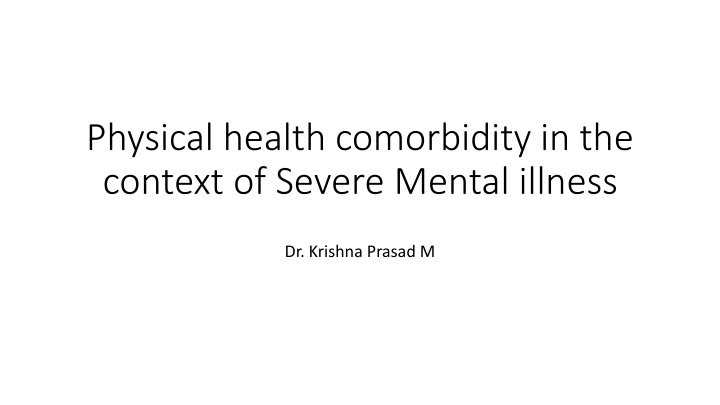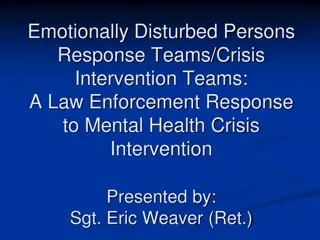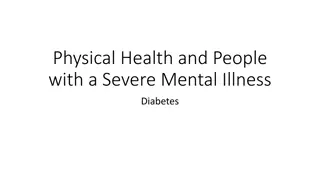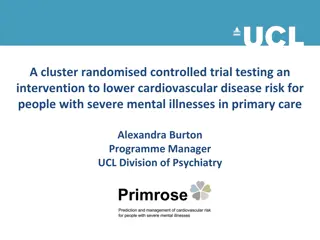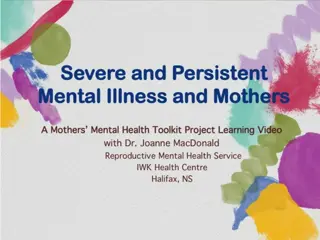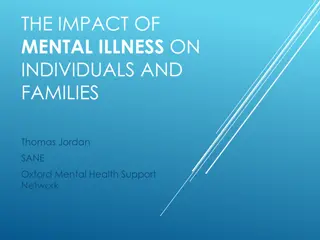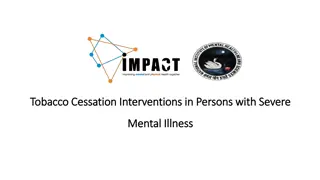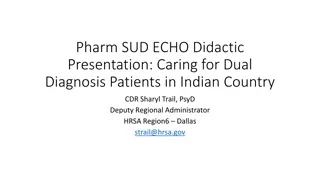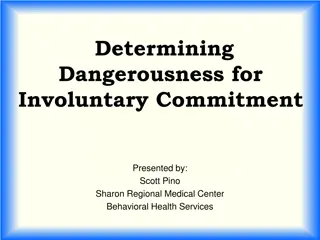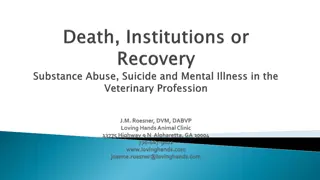Physical Health Comorbidity in Severe Mental Illness: A Critical Overview
People with severe mental illness face a substantial mortality gap, often due to preventable physical illnesses. Neglect of their physical health needs is common, with high prevalence of conditions and poorer outcomes. Reasons for neglect vary from professional to personal factors. Mortality rates among patients with schizophrenia and bipolar disorder are concerning, with cardiovascular and respiratory issues being major causes. The prevalence of metabolic syndrome in schizophrenia and bipolar disorder is also highlighted, underscoring the importance of addressing physical health in the context of severe mental illnesses.
Download Presentation

Please find below an Image/Link to download the presentation.
The content on the website is provided AS IS for your information and personal use only. It may not be sold, licensed, or shared on other websites without obtaining consent from the author.If you encounter any issues during the download, it is possible that the publisher has removed the file from their server.
You are allowed to download the files provided on this website for personal or commercial use, subject to the condition that they are used lawfully. All files are the property of their respective owners.
The content on the website is provided AS IS for your information and personal use only. It may not be sold, licensed, or shared on other websites without obtaining consent from the author.
E N D
Presentation Transcript
Physical health comorbidity in the context of Severe Mental illness Dr. Krishna Prasad M
Background People with severe mental illness die on average 10-20 years earlier than the general population Mortality gap worldwide is widening Majority of (around 80%) of deaths in people with SMI are due to preventable physical illnesses
Background Prevalence of most physical health conditions is higher and outcomes are poorer Multi-morbidity is also more common - poorer physical health and quality of life Neglect of the physical health needs of people with SMI by policymakers and healthcare services
Reasons for the neglect Professional: Competing issues mental health, social Illness: Cognitive deficits Person: Less health care seeking Research: RCTs exclude SMI
Mortality in severe mental illness Setting - patients Mortality Study Schizophrenia patients from a SMR 1.4 - 2.16 Bagewadi et al, 2016 rural community IPSS follow up of 14 years (140 SMR of 2.3 and 4.5 in males and females Dube et al, 1984 patients) ISoS analyses SMRs of 1.9, 1.86, 1.88, and 3.02 in Harrison et al, 2001 Madras, Agra, Chandigarh urban, and Chandigarh rural centers Mental hospital setting (nearly SMR - 0.356, higher in males Shinde et al, 2014 45 % with SMI) 26 year data Bipolar disorder No data available separately
Causes of mortality Setting Causes of mortality Study Rural population south Cardiovascular, respiratory 50% of Bagewadi et al, 2016 India (Schizophrenia) cases Hospital setting (45 % with Cardiovascular (43.6%), respiratory Shinde et al, 2014 SMI) (14.9%)
Metabolic syndrome in schizophrenia Setting - patients Pooled Prevalence Community based studies 10.81 % Meta-analysis of 14 Indian studies (Ganesh et al, 2016) Hospital based 33.5 % Drug na ve 11.86 % 31.8% of the patients with schizophrenia in a south Indian rural population compared to 28.9% of general population controls were diagnosed to have Metabolic syndrome (Rawat et al, 2018)
Metabolic syndrome in bipolar disorder 40 % of treated bipolar patients of a north Indian hospital (Grover et al, 2012) Bipolar patients (55 %) > schizophrenia patients (34 %) > controls (6 %) (Grover et al, 2013)
Metabolic syndrome in bipolar disorder 6 months of follow-up the prevalence of Metabolic syndrome increased by 8% and 9.4% in the bipolar and the schizophrenia groups (Malhotra et al, 2013) Higher proportion of prevalence of Insulin Resistance in Bipolar drug naive cases vs. controls (26/55 vs. 2/25) (Guha et al, 2014)
Infectious diseases - STI Patients Sero-positivity Study Newly admitted patients HIV (2%), chlamydia (10%), (Carey et al, 2007) (n=948) Hepatitis B (3%), syphilis (3%) (71 % with SMI) - NIMHANS Out-patients at CMC Vellore HIV - 1.03% (national average (Tharyan et al, 2003) 0.7 %, local population 1.8%) Institutionalized patients Australia antigen - 11 % (Chaudhury et al, with psychosis (n=100), Controls 2 % 1994) Bareilly
Service users at NIMHANS Patients (SMI) Dyslipidemia Diabetes Hypertension Obesity Inpatients (n=101) 13 6 4 14 Outpatients 7 8 5 8 (n=50) Day-care users 13 7 7 13 (n=50) Chronic inpatients 17 11 14 5 (n=36)
Service users at NIMHANS Patients with SMI Nutritional deficiencies Hypothyroidism Hepatitis B Tuberculosis Cancer Inpatients (n=101) 41- B12 17-anemia 6 - - - Outpatients (n=50) 7- B12 3-anemia 2 - - 1 ca breast Day-care users (n=50) 11-B12 4-D 3- anemia 13 - 1 2 ovarian cysts Chronic inpatients (n=36) 4-B12 2-D 7- anemia 11 5 3 1-Ovary 2 men - Leukoplakia
Special clinics Metabolic clinic visceral adiposity (n=150) - schizophrenia (37.5%), BPAD (34%) insulin resistance was as high as 20% in antipsychotic na ve (n=44) Addiction 82% had Alcohol dependence Syndrome, NDS 75 % General medical comorbidity Psychiatric comorbidity ADS 21.5% 18.1% NDS 19.95% 21.29%
Risk factors for metabolic syndrome Schizophrenia Female gender, Urban, married, age >35 years BMI > 25, family history, high calorie diet, sedentary lifestyle Antipsychotic exposure, second generation antipsychotic use continuous treatment IGF -1 deficit - might underlie insulin resistance Bipolar disorder Age, sex or current mood status not predictive in bipolar disorder
Sexually transmitted infections Engaging in risky sexual behavior (inpatients with SMI) male, using tobacco and screening positive for either drug use or alcohol problems (Chandra et al, 2003)
Tobacco use in SMI Schizophrenia 33.64%, mood disorders -33.33% (any form - inpatients) More than three fourths had markedly severe illness Dependence moderate to severe 80 to 90 % case records did not document diagnosis (Amol, 2017, unpublished)
Outcomes and economic impact SMI patients score low on domains of health responsibility and nutrition habit physical activity and stress management domain in BPAD group no studies that directly measure the economic impact of physical illnesses low functioning on GAF, poor quality of life (Malhotra et al, 2016)
Existing Interventions Psychoeducation - importance of Diet Counselling adaptive lifestyle Optimization of antipsychotics Physical activity assessment & Metformin, topiramate optimizing Referrals - Physicians, Advise about aerobic physical Endocrinologists, Gynecologists, exercises Dentists Yoga Therapy
Policy drivers integrate mental health services into general health care services at all levels of care Mental health Care Act of India ,2017 care within the existing health systems using a primary health care approach National Mental Health Policy, 2014 health workers common for NCD and mental health National health policy, 2017
Gaps services, policy No countrywide data available on prevalence Screening may happen only during inpatient care Mental hospitals - services for evaluation, treatment of physical illness are not available Barriers Lack of baseline data of prevalence of comorbidity Cost is not known No specific policy
Research priorities Prevalence and patterns of comorbidities in SMI need to be examined Direct and Indirect costs of comorbidities in SMI also need to be studied NMHS, 2016 missed an opportunity to examine
Key factors - experience Poor access to services Stigma and negative attitude towards the health of a mentally ill Cost of treatment Poor health literacy Lack of employment opportunities Poverty, low education, rural background
Human rights channels to work Framework Bodies Legislative MHCA, RPWD Judiciary and Human Rights commissions Policy - National Mental Health policy, National health policy 2017 National Commission for Women Programs - National Mental Health Mental health review boards and Programme authorities Mental Health establishments
Investigating Mental and Physical Health Comorbidity Survey in people with severe mental illness in South Asia
Primary aim To determine the prevalence of physical disorders and lifestyle health-risk behaviours in people with SMI in South Asia This will inform stakeholders about lifestyle behaviors and healthcare needs in people with severe mental illness and highlight inequalities in healthcare practices .
Settings & population National Institute of Mental Health , Dhaka Bangladesh Institute of Psychiatry , Rawalpindi Pakistan National Institute of Mental Health and Neurosciences India
Inclusion and exclusion criteria Inclusion criteria Exclusion criteria Adults Perceived lack of capacity with a clinical diagnosis of severe mental or inability to complete illness study questionnaires Able to provide informed consent
Recruitment Of Participants Random sampling 1200 out-patients and 300 in-patients will be recruited
Measures MINI version 6 WHO STEPs Version 3.2 PHQ 9, GAD 7, EQ-5D-5L Infectious diseases, Risk behaviours BP, Weight, Height, Waist Circumference HbA1C, LFT, Creatinine, Lipids, TFT, Hb
Is it relevant to psychiatric rehabilitation? Illness management core component of a recovery framework Medical comorbidities - within the scope of illness management Collaborative and reciprocal exercise Engaging patient and natural supporters
Why in a Rehabilitation program? Intrinsic skill building Environmental supports Motivational interviewing Potential sustainability
Challenges and Prospects Responsibility for physical health in patients with SMI Resources and cooperation (or lack of) Professional competence (building) Care boundaries (illness, professional, system) Time for each patient and being persistent
